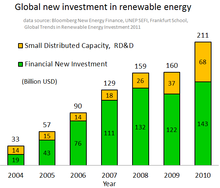Policy

Policies to support renewable energy have been vital in their expansion. Where Europe dominated in establishing energy policy in early 2000s, most countries around the world now have some form of energy policy.
Policy trends
The International Renewable Energy Agency (IRENA) is an intergovernmental organization for promoting the adoption of renewable energy worldwide. It aims to provide concrete policy advice and facilitate capacity building and technology transfer. IRENA was formed in 2009, by 75 countries signing the charter of IRENA. As of April 2019, IRENA has 160 member states. The then United Nations' Secretary-General Ban Ki-moon has said that renewable energy has the ability to lift the poorest nations to new levels of prosperity, and in September 2011 he launched the UN Sustainable Energy for All initiative to improve energy access, efficiency and the deployment of renewable energy.
The 2015 Paris Agreement on climate change motivated many countries to develop or improve renewable energy policies. In 2017, a total of 121 countries have adapted some form of renewable energy policy. National targets that year existed in at 176 countries. In addition, there is also a wide range of policies at state/provincial and local levels. Some public utilities help plan or install residential energy upgrades. Under president Barack Obama, the United States policy encouraged the uptake of renewable energy in line with commitments to the Paris agreement. Even though Trump has abandoned these goals, renewable investment is still on the rise.
Many national, state, and local governments have created green banks. A green bank is a quasi-public financial institution that uses public capital to leverage private investment in clean energy technologies. Green banks use a variety of financial tools to bridge market gaps that hinder the deployment of clean energy. The US military has also focused on the use of renewable fuels for military vehicles. Unlike fossil fuels, renewable fuels can be produced in any country, creating a strategic advantage. The US military has already committed itself to have 50% of its energy consumption come from alternative sources.
100% renewable energy
This section needs to be updated. (March 2019) |
The incentive to use 100% renewable energy, for electricity, transport, or even total primary energy supply globally, has been motivated by global warming and other ecological as well as economic concerns. The Intergovernmental Panel on Climate Change has said that there are few fundamental technological limits to integrating a portfolio of renewable energy technologies to meet most of total global energy demand. Renewable energy use has grown much faster than even advocates anticipated. At the national level, at least 30 nations around the world already have renewable energy contributing more than 20% of energy supply. Also, Professors S. Pacala and Robert H. Socolow have developed a series of "stabilization wedges" that can allow us to maintain our quality of life while avoiding catastrophic climate change, and "renewable energy sources," in aggregate, constitute the largest number of their "wedges".
Using 100% renewable energy was first suggested in a Science paper published in 1975 by Danish physicist Bent Sørensen. It was followed by several other proposals, until in 1998 the first detailed analysis of scenarios with very high shares of renewables were published. These were followed by the first detailed 100% scenarios. In 2006 a PhD thesis was published by Czisch in which it was shown that in a 100% renewable scenario energy supply could match demand in every hour of the year in Europe and North Africa. In the same year Danish Energy professor Henrik Lund published a first paper in which he addresses the optimal combination of renewables, which was followed by several other papers on the transition to 100% renewable energy in Denmark. Since then Lund has been publishing several papers on 100% renewable energy. After 2009 publications began to rise steeply, covering 100% scenarios for countries in Europe, America, Australia and other parts of the world.
In 2011 Mark Z. Jacobson, professor of civil and environmental engineering at Stanford University, and Mark Delucchi published a study on 100% renewable global energy supply in the journal Energy Policy. They found producing all new energy with wind power, solar power, and hydropower by 2030 is feasible and existing energy supply arrangements could be replaced by 2050. Barriers to implementing the renewable energy plan are seen to be "primarily social and political, not technological or economic". They also found that energy costs with a wind, solar, water system should be similar to today's energy costs.
Similarly, in the United States, the independent National Research Council has noted that "sufficient domestic renewable resources exist to allow renewable electricity to play a significant role in future electricity generation and thus help confront issues related to climate change, energy security, and the escalation of energy costs … Renewable energy is an attractive option because renewable resources available in the United States, taken collectively, can supply significantly greater amounts of electricity than the total current or projected domestic demand."
The most significant barriers to the widespread implementation of large-scale renewable energy and low carbon energy strategies are primarily political and not technological. According to the 2013 Post Carbon Pathways report, which reviewed many international studies, the key roadblocks are: climate change denial, the fossil fuels lobby, political inaction, unsustainable energy consumption, outdated energy infrastructure, and financial constraints.
According to World Bank the "below 2°C" climate scenario requires 3 billions of tonnes of metals and minerals by 2050. Supply of mined resources such as zinc, molybdenum, silver, nickel, copper must increase by up to 500%. A 2018 analysis estimated required increases in stock of metals required by various sectors from 1000% (wind power) to 87'000% (personal vehicle batteries).
Comments
Post a Comment